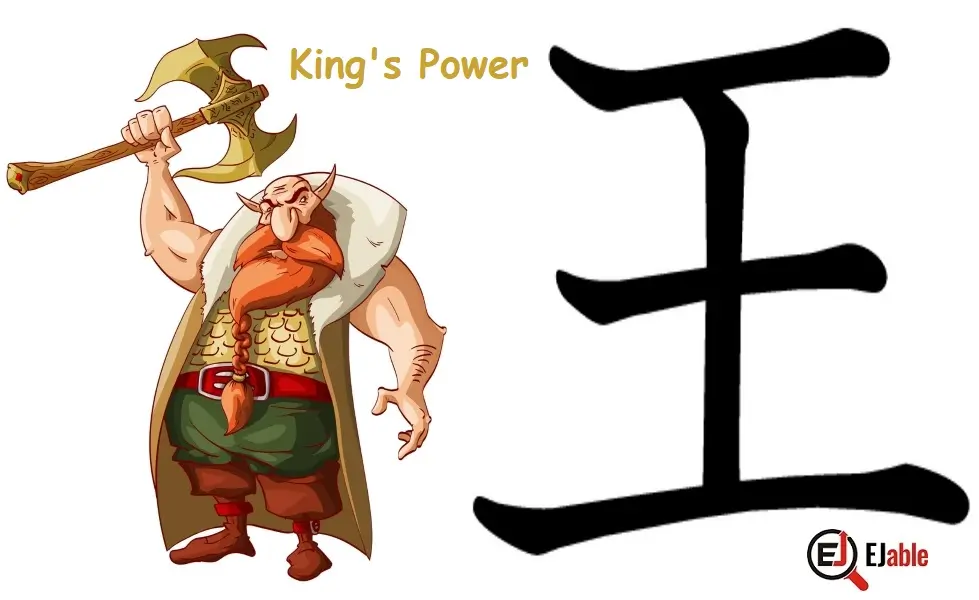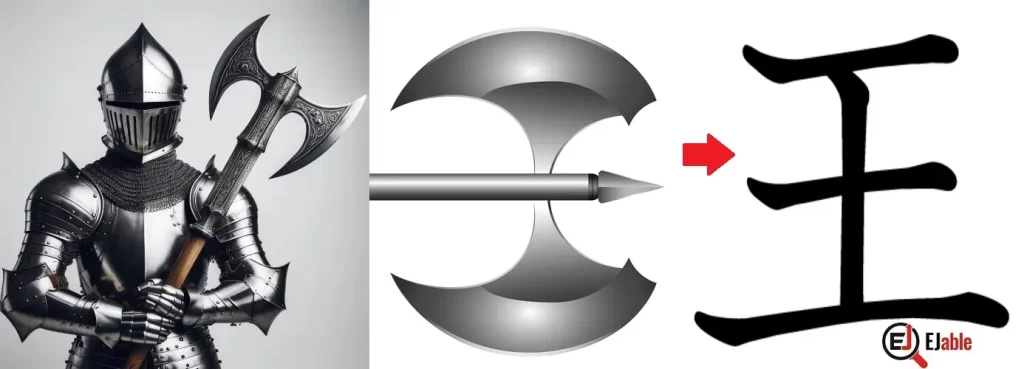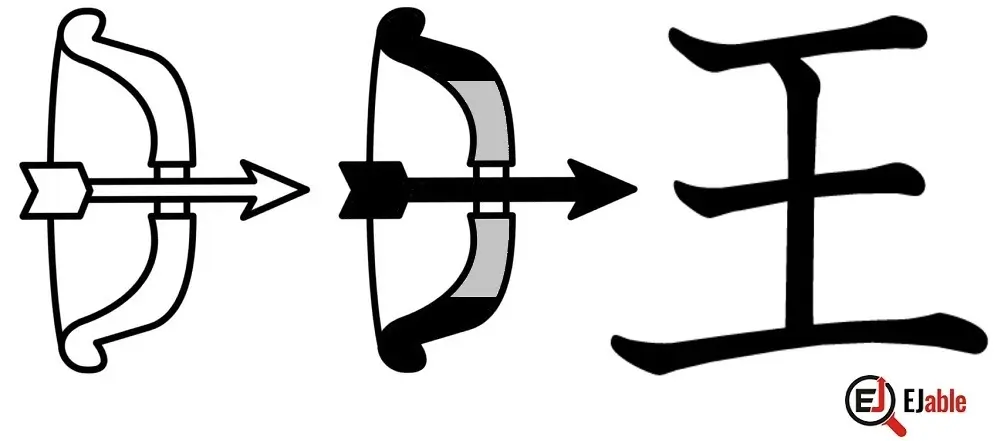Kanji for King: 王 (ō, オウ)

The Japanese Kanji for “king” is 王. The Kanji of King does not have a Kunyomi or Japanese reading pronunciation. Its onyumi reading is “ō” (オウ).
The Kanji 王 is part of JLPT N3 (please check the list of JLPT N3 Kanji) and is taught in grade 1 in Japanese schools.
This Kanji has an interesting history and origin and carries other meanings in various contexts. This article discusses various aspects of this Kanji and easy ways to remember it.
Construction and Origin and Evolution of the Shape 王
King’s Kanji has a very simple construction with 4 strokes, out of which 3 are horizontal lines with one vertical line joining them at the center.
- Pictographic Origin: The Kanji for king 王 is believed to have a pictographic origin in ancient Chinese scripts. It originally depicted a Battle Axe, symbolizing authority and power. Over time, this pictogram evolved into a more abstract representation of a ruler or king.
- Evolution Over Time: The character’s form simplified over centuries. It may have had more complex imagery in its earliest forms, but it gradually evolved into the simpler, more symmetrical form we know today.
Mnemonics: How to Remember the Kanji of King (王)
Traditionally, kings were associated with battles and wars. As mentioned above, the modern interpretation of Kings’ Kanji is a pictogram of a double-edged battle axe. This simple logic is a good mnemonic to remember the kanji for king quickly.
However, to make it easier, you can use the following two illustrations as mnemonics to remember this kanji:
Mnemonic 1: A Pictogram of King’s Battle Axe


Explanation of Mnemonic 1:
As illustrated above, the pictogram of the battle axe as Kings Kanji has the following parts:
- The two horizontal lines at the top and bottom represent the two blades (bits).
- The horizontal line at the center is the axe’s handle or haft on one side.
- On the other side of the axe’s eye, opposite the handle, is a sharp protrusion.
Mnemonic 1: A Pictogram of King’s Bow and Arrow
As an alternative, you can also picture a bow and arrow to represent a king as follows:


Explanation of Mnemonic 2:
- The top and bottom horizontal lines represent the top and bottom parts of the bow.
- The horizontal line at the center represents the arrow,
王 as a Radical and Component in other Kanji Characters
Kanji for “king” 王 (ō) does appear as a Kanji radical in other Kanji characters. 王 appears as a radical or component in 449 Kanji characters, including 85 Jōyō Kanji.
When used as a radical, it often imparts meanings related to royalty, authority, or the concept of a ruler. However, as mentioned under the heading of “Confusing Kanji Radicals” in our guide about Kanji radicals, the radicals of Kanji characters 王 (King) and 玉 (Jade) are generally the same and appear as 王.
Examples of 王 as a Radical
Here are some examples of Kanji where the 王 radical is present; however, in most of the following examples, the radical does not carry the meaning of King but that of a Jade:
- 現 (げん / gen): To appear, present. This Kanji combines “king” with “see,” implying something worthy of a king’s attention.
- 球 (きゅう / kyū): Sphere, ball.
- 環 (かん / kan): Ring, circle.
- 珍 (ちん / chin): Rare, precious
- 瑞 (ずい / zui): Omen, auspicious.
- 瑶 (よう / yō): Beautiful jade.
- 瑠 (る / ru): Lapis lazuli.
- 璽 (じ / ji): Imperial seal; includes “king” and “tiger,” symbolizing royal authority.
- 璧 (へき / heki): Complete jade disc.
- 瑛 (えい / ei): Sparkle of a jewel.
- 璃 (り / ri): Glass, crystal.
- 班 (はん / han): Group, squad.
- 玩 (がん / gan): To play with.
- 珠 (しゅ / shu): Pearl, bead.
These Kanji characters illustrate how the King’s Kanji (王) radical contributes to the meaning and symbolism of the characters, often implying value, beauty, rarity, or authority.
King (ō) Kanji in Compounded Words
In Japanese, 王 appears in compound words (jukugo) like 王子 (ōji, meaning “prince”) and 王女 (ōjo, meaning “princess”), extending its usage beyond the standalone meaning of “king.”
There are 65 Japanese words that begin with the Kanji 王, and it appears in 204 words.
Examples of Kanji 王 in Compounded Kanji Characters
Following are the examples where Kanji for King appears in Japanese compounded Kanji characters:
- 王様 (おうさま / ōsama): King; a respectful and common term for a king.
- 王子 (おうじ / ōji): Prince. This Kanji literally means “king’s child.”
- 王女 (おうじょ / ōjo): Princess
- 王国 (おうこく / ōkoku): Kingdom; a country ruled by a king.
- 王冠 (おうかん / ōkan): Crown; the headwear of a king.
- 王位 (おうい / ōi): Kingship, royal throne.
- 王朝 (おうちょう / ōchō): Dynasty; a period during which a particular king’s family rules.
- 王宮 (おうきゅう / ōkyū): Royal palace.
- 女王 (じょおう / joō): Queen; the female equivalent of a king.
- 天王星 (てんのうせい / tennōsei): The planet Uranus, literally “Heavenly King Star.”
- 棋王 (きおう / kiō): “King of Chess” or a title in Shogi (Japanese chess).
- 海王星 (かいおうせい / kaiōsei): The planet Neptune, literally “Sea King Star.”
- 象王 (ぞうおう / zōō): A title in Shogi, literally “Elephant King.”
- 金王 (きんおう / kinō): Gold king; a term in Shogi for the gold general piece.
- 竜王 (りゅうおう / ryūō): “Dragon King”; a title in Shogi, also used to refer to a dragon in mythology.
Cultural and Symbolic References of the King’s Kanji 王
“The Kanji 王, representing ‘king,’ carries cultural and symbolic significance in Japanese literature, folklore, and everyday expressions. Its usage in various contexts extends beyond the meaning of a “King”, to indicate leadership, excellence, and superiority.
Not Just a Ruler
In Japanese culture, the concept of a ‘king’ is deeply rooted in historical narratives where a king is also a symbol of moral and ethical standards. Consequently, 王 is frequently used in proverbs and idioms to express ideals of leadership and governance. For example, phrases that include 王 often imply standards denoting the highest level of achievement or quality in a given domain.
King, as the symbol of Quality and Class
In literature and folklore, characters compared to a 王 are typically those who can be considered the perfect examples of quality and class for a particular trait or skill. This use elevates the character’s status for their abilities, highlighting their qualities traditionally associated with kingship, such as wisdom, bravery, and justice.
As a Symbol of Power and Perfection
Moreover, 王 appears in modern cultural expressions and is often used symbolically to describe someone who is the best in their specific field, be it crafts, art, or sports. Such people excelling in their domains m might be referred to as the 王 of their respective domains. In such cases, the Kanji 王 highlights their dominance and exceptional skill.
Check other Kanji characters on the page “How to Remember Kanji“. You may also like to read about the common Kanji radicals.


A long-term ex-pat in Japan, Himanshu comes with an IT background in SAP consulting, IT Business Development, and then running the country operations of an IT consulting multinational. Himanshu is the co-founder and Managing Director of ReachExt K.K. and EJable.com. He is also an Advisory Board Member of a Silicon Valley AI/IoT startup.

